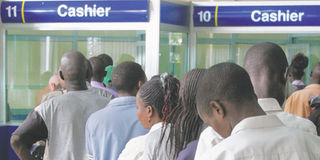Kenya goes the extra mile to light up homes

Consumers line up to pay their electricity bills. Kenya Power, plans that by 2020, 45 per cent of the population will be connected to the national grid. Photo/FILE
What you need to know:
- Kenya is banking on a mix of internal and foreign funding in order to connect all Kenyans to the vital resource
Despite having a low electricity penetration rate currently estimated at just 32 per cent of the population, Kenya is leaving nothing to chance in lighting up all homes knowing that access to electricity by its populace is vital to the country's national development.
Kenya is banking on a healthy mix of internal and foreign funding in order to connect all Kenyans to the vital resource.
The country also requires independent power producers (IPPs) to augment power generation.
However these IPPs require government guarantees before they can commence power generation.
The country's sole electricity distribution firm, Kenya Power, plans that by 2020, 45 per cent of the population will be connected to the national grid.
Currently, the country has an installed capacity of 1,529 megawatts (MW) against peak demand of 15,000 MW by 2030.
The government has also realised the importance of cheap power as a critical input for the private sector to flourish in globally competitive arena.
Presently the average cost of power in Kenya is 15 U.S. cents per Kilo watt hour (kWh).
Kenya Power Managing Director Joseph Njoroge said that as of 2011 the country's energy mix consisted of 12 per cent geothermal, 48 per cent hydro, 38 per cent thermal and 2 per cent co-generation.
"However by 2016, the composition will change to 25 per cent geothermal, 24 per cent wind, 24 per cent thermal, 11 per cent hydro, 9 per cent coal, 6 per cent imports while 1 per cent will be provided through co-generation," Njoroge said during the Nairobi county stakeholders forum for electricity customers.
The firm receives on average 45 per cent of revenue from customer billings. The rest goes to government as taxes and levies and power generators.
In order to meet growing demand, the country has embarked on a number of initiatives.
In July the World Bank approved financing to the tune of 243 million dollars to Ethiopia and another 441 million dollars to Kenya in order to connect the national grids of both countries.
Once the project is complete, electricity will become a commodity that can be traded within the region.
The managing director revealed the firm hopes to enter into a joint venture in order to produce transformers locally.
Kenya Power Chief Manager for Nairobi Engineer Joseph Masibo said his firm has planned a distribution expansion plan within Nairobi to the tune of 85 million dollars as part of plans to reduce losses of electricity during transmission.
Masibo added the power company is working closely with local communities to ensure that trees don't interfere with power lines.
He noted other distribution strategic initiatives include undergrounding of electricity lines in order to reduce electricity line breaks in urban areas as well as enhance public safety.
The firm is also introducing dry type transformer in order to reduce cases of vandalism.
He said main challenges facing delivery is vandalism which is responsible for longer duration of outages.
Masibo noted new customers are more dispersed and require longer distances to travel. Through a myriad of service delivery innovations the company hopes to achieve its electrification goals.
Back in 2009, the company piloted pre-paid electricity scheme. The company hopes to connect 520,000 customers by June 2015.
It has also introduced electricity revolving fund to enable new customers to get connected on the national grid.
Additionally the firm has distributed about 1.25 million energy efficiency bulbs.
The company is also conducting a power market study by an independent consultant to make appropriate changes on the current tariff regime in order to reduce the traffic burden on customers.
Nuclear Electricity Project Committee member Karanja Kabage said that for a nation to develop it requires sufficiency of power supply.
"There is strong relation between energy supply and Gross Domestic Product and so as a government we have decided to tap nuclear power," he said.
He said hydro power is heavily reliant on weather while geothermal cannot cover all energy needs required in 2030, so nuclear will be a major input to Kenya's generation mix.
Karanja noted Kenya will have to train nuclear scientists before the country can enjoy any power from this source.
Lake Turkana Wind Project Chairman Carlo Van Wageningen said his 300 MW plant is set to be fully completed by the end of 2014.
Vision 2030 Director Mugo Kibati said electricity will be key if industrialisation effort bears fruit.




